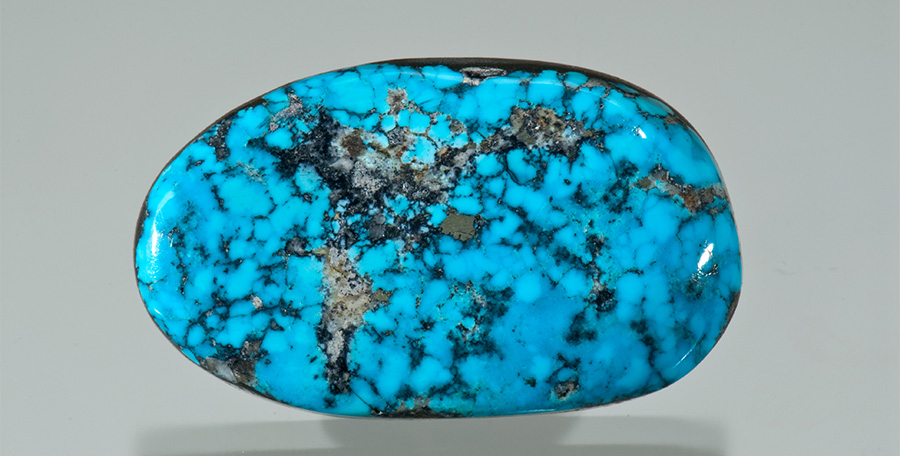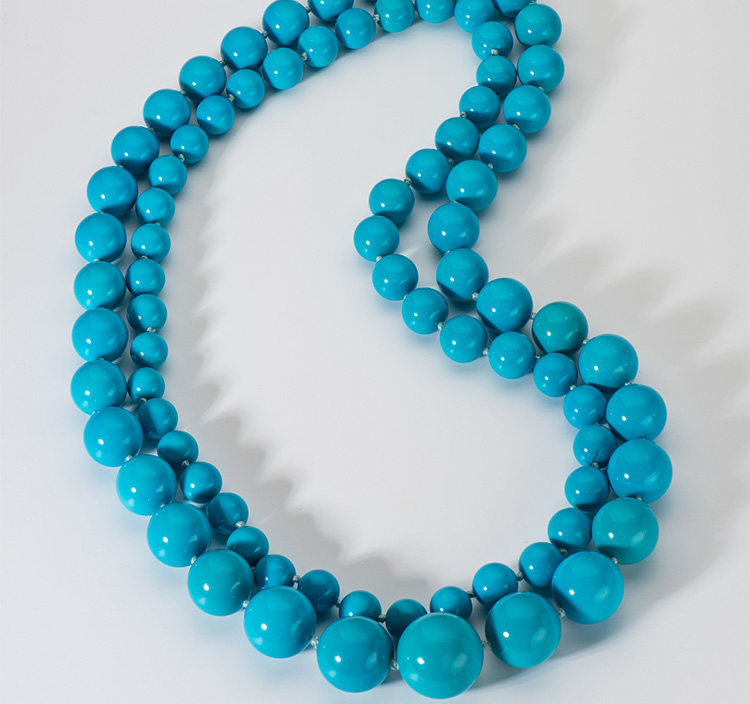December Birthstones
Turquoise, Tanzanite & Zircon
December’s birthstones are zircon, tanzanite, and turquoise. You can select the birthstone that best suits your style from among these blue-hued December birthstones, which are mined all over the world. Find out more about their past and current locations.

Which birthstone for December would you choose if you had to: tanzanite, turquoise, or zircon? There is a colour for everyone, whether it is the blue to bluish purple of tanzanite, the strong blue and green of turquoise, or the rainbow hues of zircon. If blue is what you’re after, each of the three birthstones for December has an own spin on this favourite colour. We can assist you in choosing the ideal December birthstone for you or a loved one, regardless of your preferences for colour, design, or price range.
Turquoise Birthstone Meaning & History
Blue to green in colour, turquoise is a semi-translucent to opaque gem that frequently has matrix veins (remains of the rock it formed in) running through it. For millennia, people have treasured the birthstone for December. It was used to embellish the pharaohs and other ancient Egyptian kings. It was sculpted by Chinese artists more than 3,000 years ago.
The birthstone of turquoise was believed to have numerous positive properties, such as ensuring health and fortune. It was thought, starting in the 13th century, that it would shatter into numerous pieces as tragedy approached and would shield the wearer from falling (particularly off horses). According to Hindu mystics, seeing a turquoise after viewing the new moon guaranteed incredible fortune.
Native Americans also placed a high value on this birthstone of turquoise. The Apache believed that by travelling to the end of a rainbow, one may find turquoise. Additionally, they thought that securing the birthstone for December to a bow or gun improved one’s marksmanship. The Hopi believed that lizards crawling across the earth generated the diamond, whereas the Pueblo insisted that turquoise’s colour came from the sky.

The funeral mask of King Tut, who ruled Egypt more than 3,000 years ago, is adorned with this December birthstone. Additionally, it can be found in the jewellery of more recent royals. For example, Wallis Simpson (1896-1986), Duchess of Windsor and recipient of King Edward VIII’s abdication, wore a well-known Cartier necklace made of amethyst and turquoise. The gem for the 11th wedding anniversary is turquoise.
A turquoise ring is a common gift in Europe that is intended to convey the message, “forget me not.” In Tibet, turquoise is revered as a national treasure and is thought to bestow good health, riches, and protection from evil. The birthstone for December also brings tranquilly to individuals who wear it.
Turquoise Source
In Iran’s Nishapur region, turquoise has been mined for more than a millennium. The terms “robin’s egg blue,” “sky blue,” and “Persian blue” are all used to describe the highly sought-after, intensely blue turquoise from this region. Regardless of the provenance, trade experts now refer to turquoise of this colour using these words.

Up until the 1920s, New Mexico was the country’s top producer of turquoise, but today Arizona and Nevada account for the majority of the nation’s output of this birthstone for December. Names of mines like Dry Creek, Easter Blue, Emerald Valley, and Fox are evocative. A historically significant source that is well-known for producing deep blue turquoise is the Kingman mine in Arizona. Arizona’s Sleeping Beauty mine, which is now closed to turquoise mining, was a productive producer for more than 40 years.
The main producer of this December birthstone today is China. The majority of the gem-quality turquoise being mined in China comes from Hubei Province.
Turquoise Care & Cleaning
Some turquoise is treated to enhance its toughness (Mohs scale: 5–6), appearance, and gloss. For more hardness or better colour, turquoise can be coloured or chemically improved by adding an epoxy or acrylic resin. In order to mimic pyrite inclusions, cavities filled with a metal-loaded epoxy are also visible.
Although turquoise is usually resistant to light, extreme heat can lead to deterioration and breakage. Your turquoise birthstone can be harmed by acids, and it can also be stained by some substances, cosmetics, and even sweat or oil from the skin. Turquoise jewellery can be cleaned with warm, soapy water without harm, but steam or ultrasonic cleaners should never be used on this December birthstone. Some turquoise’s coated surfaces can be harmed by heat or chemicals.

Tanzanite Birthstone Meaning & History
One of the most fascinating gem discoveries of the 20th century was tanzanite, despite its relative youth in the world of coloured stones. In 1962, Tanzanian blue stones were recognised as the mineral zoisite. Prospectors didn’t discover the Merelani Hills as the principal source for this December birthstone until 1967, though. In honour of its home nation, Tanzania, it was eventually given the name tanzanite. The birthstone tanzanite is frequently referred to as “velvety,” primarily due to its intense and saturated colour, which ranges from a pure rich blue to violet, with the blue being the most valued.
Because Tiffany & Co. thought tanzanite had a broad market, they became the stone’s primary distributor. Tiffany started a significant advertising push to market it in 1968.Tanzanite soon gained popularity due to its striking colours, exceptional clarity, and capability for producing huge cut stones. Today, it serves as the gemstone for the 24th wedding anniversary in addition of being the birthstone for December.

Tanzanite Source
The only site on earth where tanzanite is commercially mined is in northern Tanzania’s Merelani Hills. The surroundings consist of rocky terrain, scrub vegetation, grass-covered hillsides, and the occasional tree. Thousands of people retrieve tanzanite from mines sunk more than 100 metres (more than 300 feet) deep into the ground in the big mechanised operations there. The snow-covered slopes of Mount Kilimanjaro tower to the north of the mines.

Tanzanite Care & Cleaning
This Mohs scale of hardness gemstone for December, which ranges from 6 to 7, is resistant to common chemicals, light, and heat. However, the December birthstone is readily abraded and is susceptible to cracking when exposed to extremely high temperatures or abrupt temperature fluctuations. Acids like hydrochloric and hydrofluoric can damage it.
Most tanzanites start out as brownish zoisite and are then heated to achieve the blue to violet tones that make them the birthstone for December. There are no additional issues regarding durability because the finished colour is permanent.
Earrings or pendants are the ideal settings for your tanzanite birthstone. Although it is not advised to wear a ring every day, the December birthstone can make a lovely special-occasion accessory with a protective mounting and little maintenance.
The finest cleaning solution for this December birthstone is warm, soapy water. It is never advised to use an ultrasonic or steam cleaner on tanzanite.

Zircon Meaning & History
The word “zircon”‘s etymology has given rise to a lively controversy. According to some experts, it originates from the Arabic term zarkun, which means “cinnabar” or “vermilion.” Some believe the name’s origins are in the Persian word zargun, which means “gold coloured.” Either derivation appears plausible given the varied colour palette for this December birthstone, which includes red, orange, yellow, brown, green, and blue. Zircon is famed for its brilliance and flashes of multicoloured light, known as fire, which have caused it to be mistaken for diamond for millennia.
This December birthstone was once supposed to ease wearers into sound sleep and ward off bad spirits throughout the Middle Ages. As one of the nine gems of the navaratna in the Hindu religion, zircon alternates with hessonite garnet.
The nine stones protect the wearer and bestow prosperity, knowledge, and good health when worn all at once.
Blue zircon was a favourite of the Victorians. Fine examples can be seen in 1880s English estate jewellery.

Zircon Source
The abundance of jewels in Sri Lanka is legendary: Some of the gem minerals found there include quartz, ruby, alexandrite, spinel, tourmaline, moonstone, and sapphire in a variety of colours. So too is zircon, the birthstone for December. One of Sri Lanka’s most fruitful regions is Elahera, which is located in the centre of the island. A dramatic environment is made up of mountains, jungles, and turbulent streams.

Zircon birthstones in the colours of pink, purple, orange, and yellow-brown are famously produced in Australia’s Harts Range. If you go there, you will find wide-open savannahs, dried-up creek beds, and low hills that stretch into the distance. This December birthstone is mined on Zircon Hill. The surrounding city of Alice Springs is well-known for its indigenous art, outback culture, and oddball athletic events like a regatta race that takes place in a dried-up riverbed.
This December birthstone is frequently found close to sapphire deposits. Myanmar, Vietnam, and Cambodia are among the nations where the two jewels intersect in addition to Sri Lanka and Australia.
Zircon Care & Cleaning
The hardness of ircon ranges from 6 to 7.5 on the Mohs scale. It is frequently heated to make orange, yellow, red, blue, and colourless variations. The gem is typically stable in the presence of light, but after prolonged exposure to bright light, certain heat-treated stones may return to their native colours, which are typically light brown. Some zircons can change colour when exposed to heat. When exposed to chemicals, this birthstone for December remains stable.
Zircon tends to abrade, thus it is recommended to avoid wearing it in demanding activities like gardening, athletics, or household chores.
Use a gentle brush and warm water with light soap to clean your zircon. This birthstone for December should not be cleaned with an ultrasonic or steam cleaner.

